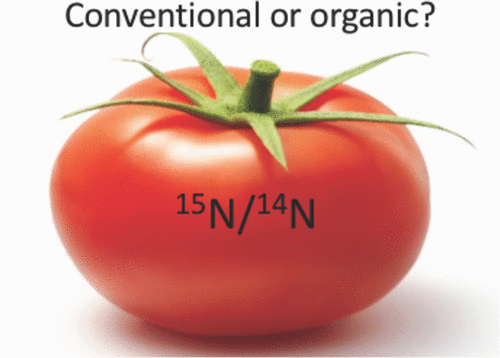Our official English website, www.x-mol.net, welcomes your feedback! (Note: you will need to create a separate account there.)
Nitrogen Isotope Composition, Nitrogen Amount, and Fruit Yield of Tomato Plants Affected by the Soil–Fertilizer Types
ACS Omega ( IF 4.1 ) Pub Date : 2018-06-14 00:00:00 , DOI: 10.1021/acsomega.8b00296 Marlee A. Trandel 1 , April Vigardt 1 , S. Alan Walters 2 , Mihai Lefticariu , Mary Kinsel
ACS Omega ( IF 4.1 ) Pub Date : 2018-06-14 00:00:00 , DOI: 10.1021/acsomega.8b00296 Marlee A. Trandel 1 , April Vigardt 1 , S. Alan Walters 2 , Mihai Lefticariu , Mary Kinsel
Affiliation

|
Tomatoes (Solanum lycopersicum) are heavy nutrient feeding crops and require high amounts of nitrogen to maximize fruit production. The type of nitrogen applied and timing of fertilizer applications are important to reduce losses due to volatilization and leaching. Previous research suggested that nitrogen stable isotopes are a useful fingerprinting system for indicating if a crop has been grown with synthetic or organic nitrogen applications. To study the effects of fertilization systems on nitrogen isotopic patterns, “Better Bush” tomatoes were grown in a 2 year greenhouse experiment to analyze nitrogen isotopic composition, nitrogen content, and fruit yield. Three main soil fertility treatments were evaluated, and the results were compared to those obtained on plants grown in unfertilized soil: conventional inorganic (synthetic Miracle Grow (MG)), organic (bonemeal and bloodmeal (BB), BB with liquid Earth Juice (BBL), BB with 25% vermicompost (VC), BBL with 25% VC, and 25% VC), and mixed (MG with 25% VC). The soil fertilizers, treated and untreated soil, immature and mature leaflets tomato fruit peels, and fruit juices were analyzed for both nitrogen isotope ratios and nitrogen concentrations. Plant δ15Nair decreased in the order organic treatment-no fertilizer-mixed treatment-conventional treatment. The average δ15Nair values in leaves, fruit peels, and juice from plants grown with organic treatments ranged from 4.5 to 11.9, 5.4 to 10.1, and 6.1 to 11.1‰, respectively, whereas in the case of the inorganic treatment, the average δ15Nair values varied between −3.0 and 0.4, −1.1 and 0.4, and −0.9 and 1.9‰, respectively. Plant nitrogen concentrations in tomato decreased in the following order (from highest to lowest): inorganic soil fertility treatment, mixed treatments, and organic and control (no fertilizer) treatment. The average weight %N values in leaves and fruit peels from plants grown with organic treatments ranged from 1.3 to 4.2 and 1.1 to 2.3%, respectively, whereas in the case of the inorganic treatment, the average weight %N values varied between 3.7 and 5 and 1.3 and 2.8%, respectively. Plants grown under organic treatments have higher δ15Nair, lower weight %N, and are enriched in 15N compared with the original soil than plants grown with inorganic fertilizer, suggesting that the synthetic nitrogen sources are more readily available for plant uptake than the organic ones. The addition of vermicompost increases both δ15Nair and weight %N in plants. Tomato fruit yields did not differ between cluster 1 and cluster 2 harvest, however, total tomato fruit yields differed indicating that synthetically fertilized plants produced the highest total yields (g) (P ≤ 0.05). However, all treatments with VC soil applications indicated an increase in the amount of plant nitrogen, fruit yield, soil cation exchange capacity, soil organic matter content, and released soil nitrogen. Nitrogen isotope ratios of tomatoes can be used to distinguish among various soil fertility treatments, therefore fingerprinting the organic fertilizer applications.
中文翻译:

土壤肥料类型对番茄植株氮同位素组成,氮素含量和果实产量的影响
西红柿(番茄)是重养分的农作物,需要大量的氮才能最大限度地提高果实产量。施氮的类型和施肥的时间对于减少由于挥发和浸出造成的损失很重要。先前的研究表明,氮稳定同位素是一种有用的指纹识别系统,可用于指示是否已使用合成或有机氮技术种植了农作物。为了研究施肥系统对氮同位素模式的影响,在为期2年的温室实验中种植了“更好的布什”番茄,以分析氮同位素组成,氮含量和果实产量。评估了三种主要的土壤肥力处理方法,并将结果与在未施肥的土壤中生长的植物上获得的结果进行了比较:常规无机肥料(合成奇迹生长(MG)),有机(骨和血粉(BB),含液态地球汁(BBL)的BB,含25%mi子草(VC)的BB,含25%VC和25%VC的BBL)和混合食品(含25%VC的MG)。分析了土壤肥料,未处理和未处理的土壤,未成熟和成熟的小叶番茄果皮以及果汁中的氮同位素比和氮浓度。植物δ按有机处理-不施肥-常规处理的顺序减少15 N空气。平均δ 15 Ñ空气与有机治疗生长值在叶,果皮,和果汁从植物从4.5不等至11.9,5.4至10.1,和6.1至11.1‰,分别,而在无机处理的情况下,平均δ 15 ñ空气值分别在-3.0和0.4之间,-1.1和0.4之间以及-0.9和1.9‰之间变化。番茄中的植物氮浓度按以下顺序降低(从最高到最低):无机土壤肥力处理,混合处理以及有机和对照(不施肥)处理。经过有机处理的植物叶片和果皮中的平均重量%N值分别在1.3%至4.2%和1.1%至2.3%的范围内,而在无机处理的情况下,平均重量%N值在3.7%至5%之间变化分别为1.3和2.8%。下有机处理生长的植物具有更高的δ 15 Ñ空气,较低的重量%的N,和在富集15与原始土壤相比,氮比无机肥料种植的植物多,这表明合成氮源比有机氮源更容易被植物吸收。加入蚯蚓增加两者δ的15 ñ空气在植物和重量%N。在第1组和第2组收获之间,番茄果实的产量没有差异,但是,番茄果实的总产量有所不同,这表明合成施肥的植物产生了最高的总产量(g)(P≤0.05)。但是,使用VC土壤处理的所有处理均表明植物氮素含量,果实产量,土壤阳离子交换能力,土壤有机质含量和释放的土壤氮素均有所增加。番茄的氮同位素比可以用来区分各种土壤肥力处理方法,因此可以识别出有机肥的施用情况。
更新日期:2018-06-14
中文翻译:

土壤肥料类型对番茄植株氮同位素组成,氮素含量和果实产量的影响
西红柿(番茄)是重养分的农作物,需要大量的氮才能最大限度地提高果实产量。施氮的类型和施肥的时间对于减少由于挥发和浸出造成的损失很重要。先前的研究表明,氮稳定同位素是一种有用的指纹识别系统,可用于指示是否已使用合成或有机氮技术种植了农作物。为了研究施肥系统对氮同位素模式的影响,在为期2年的温室实验中种植了“更好的布什”番茄,以分析氮同位素组成,氮含量和果实产量。评估了三种主要的土壤肥力处理方法,并将结果与在未施肥的土壤中生长的植物上获得的结果进行了比较:常规无机肥料(合成奇迹生长(MG)),有机(骨和血粉(BB),含液态地球汁(BBL)的BB,含25%mi子草(VC)的BB,含25%VC和25%VC的BBL)和混合食品(含25%VC的MG)。分析了土壤肥料,未处理和未处理的土壤,未成熟和成熟的小叶番茄果皮以及果汁中的氮同位素比和氮浓度。植物δ按有机处理-不施肥-常规处理的顺序减少15 N空气。平均δ 15 Ñ空气与有机治疗生长值在叶,果皮,和果汁从植物从4.5不等至11.9,5.4至10.1,和6.1至11.1‰,分别,而在无机处理的情况下,平均δ 15 ñ空气值分别在-3.0和0.4之间,-1.1和0.4之间以及-0.9和1.9‰之间变化。番茄中的植物氮浓度按以下顺序降低(从最高到最低):无机土壤肥力处理,混合处理以及有机和对照(不施肥)处理。经过有机处理的植物叶片和果皮中的平均重量%N值分别在1.3%至4.2%和1.1%至2.3%的范围内,而在无机处理的情况下,平均重量%N值在3.7%至5%之间变化分别为1.3和2.8%。下有机处理生长的植物具有更高的δ 15 Ñ空气,较低的重量%的N,和在富集15与原始土壤相比,氮比无机肥料种植的植物多,这表明合成氮源比有机氮源更容易被植物吸收。加入蚯蚓增加两者δ的15 ñ空气在植物和重量%N。在第1组和第2组收获之间,番茄果实的产量没有差异,但是,番茄果实的总产量有所不同,这表明合成施肥的植物产生了最高的总产量(g)(P≤0.05)。但是,使用VC土壤处理的所有处理均表明植物氮素含量,果实产量,土壤阳离子交换能力,土壤有机质含量和释放的土壤氮素均有所增加。番茄的氮同位素比可以用来区分各种土壤肥力处理方法,因此可以识别出有机肥的施用情况。


























 京公网安备 11010802027423号
京公网安备 11010802027423号